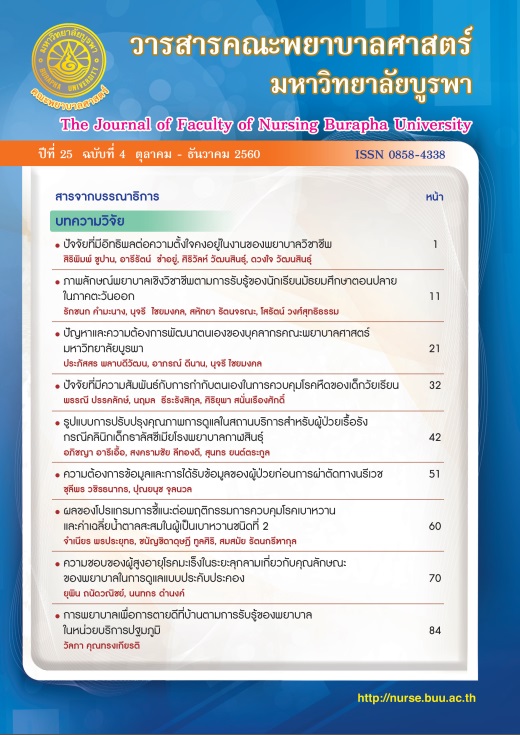การพยาบาลเพื่อการตายดีที่บ้านตามการรับรู้ของพยาบาลในหน่วยบริการปฐมภูมิ*
Good Death Nursing Care at Home as Perceived by the Nurses in a Primary Care Unit
Keywords:
การตายดีที่บ้าน, การพยาบาลเพื่อการตายดีที่บ้าน, พยาบาลในหน่วยบริการปฐมภูมิ, Good death at home, good death nursing care at home, nurse in a primary care unitAbstract
บทคัดย่อ
การวิจัยเชิงคุณภาพแบบปรากฏการณ์วิทยาของไฮเดกเกอร์ครั้งนี้มีวัตถุประสงค์เพื่อบรรยายการพยาบาลเพื่อตายดีที่บ้านตามการรับรู้ของพยาบาลในหน่วยบริการปฐมภูมิ ผู้ให้ข้อมูลเป็นพยาบาลวิชาชีพที่ปฏิบัติงานในโรงพยาบาลส่งเสริมสุขภาพตำบลแห่งหนึ่ง จังหวัดชลบุรี ผู้ให้ข้อมูลคัดเลือกแบบเฉพาะเจาะจงตามคุณสมบัติที่กำหนดจำนวน 13 คน เก็บข้อมูลระหว่างเดือนมิถุนายน ถึงเดือนกันยายน 2559 โดยวิธีการสัมภาษณ์แบบเจาะลึก การสังเกต และการสะท้อนคิด วิเคราะห์ข้อมูลตามขั้นตอนของโคเฮน คาห์น และสตีฟส์ และสร้างความน่าเชื่อถือในการวิจัยตามแนวทางของลินคอนและกูบา
ผลการศึกษาพบ ประเด็นหลักเกี่ยวกับการพยาบาลเพื่อตายดีที่บ้านตามการรับรู้ของพยาบาลในหน่วยบริการปฐมภูมิ รวม 5 ประเด็น คือ การไม่ทุกข์ทรมาน การส่งเสริมความสุขสบาย การเตรียมญาติเพื่อการดูแล ความร่วมมือของทีม และความจำกัดในการดูแล ผลการศึกษาครั้งนี้ ทำให้เกิดความเข้าใจที่ลึกซึ้งถึงการพยาบาลเพื่อตายดีที่บ้านตามการรับรู้ของพยาบาลในหน่วยบริการปฐมภูมิ ทำให้สามารถนำมาเป็นข้อมูลพื้นฐานสำหรับพยาบาลในการให้การพยาบาลเพื่อการตายดีและทำวิจัยต่อไปเพื่อความเข้าใจที่มากขึ้นซึ่งจะเป็นการพัฒนาองค์ความรู้เกี่ยวกับการพยาบาลเพื่อให้ผู้ป่วยเกิดการตายที่ดีต่อไป
-------------------
Abstract
This qualitative research based on Heideggerian phenomenology aimed to describe good death nursing care at home as perceived by nurses in a primary care unit. Thirteen informants who were the nurses at a district health promoting hospital in Chon Buri province were purposively selected. Data were collected by in-depth interview, observation and critical reflection during June to September, 2016. Cohen, Kahn and Steeves’s steps guided data analysis. Trustworthiness of the research was maintained according to guidelines of Lincoln and Guba. Five themes of good death nursing care at home as perceived by the nurses in a primary care unit emerged. They included no suffering, providing comfort, preparing relatives for caring, teams’ collaboration, and limitation of caring.
These findings provide deep understanding of good death nursing care at home as perceived by the nurses in a primary care unit. It could be utilized as basic information for nurses to provide good death nursing care and further explore for greater understanding to develop a body of knowledge regarding good death nursing care at home.
References
http://www.dms.moph.go.th/dmsweb/cpgcorner/แนวทางการดูแลผู้ป่วยระยะสุดท้าย.pdf
ทัศนีย์ ทองประทีป. (2552). พยาบาล: เพื่อนร่วมทุกข์ผู้ป่วยระยะสุดท้าย (พิมพ์ครั้งที่ 2).
กรุงเทพฯ: บริษัท วี. พรินท์ (1991) จำกัด.
วิจิตร ศรีสุพรรณ และกาญจนา จันทร์ไทย. (2556). คู่มือปฏิบัติงานพยาบาลวิชาชีพโรงพยาบาลส่งเสริม
สุขภาพตำบล.กรุงเทพฯ: บริษัท จุดทอง จำกัด
วัลภา คุณทรงเกียรติ. (2557). การพยาบาลเพื่อการตายดีตามการรับรู้ของพยาบาลวิชาชีพ. วารสาร
คณะพยาบาลศาสตร์ มหาวิทยาลัยบูรพา, 22(3),69-86.
ศศิธร ธนะภพ และรพีพร ขวัญเชื้อ. (2558). ความจำเป็นของการดูแลแบบประคับประคองในชุมชนของผู้ป่วย
โรคเรื้อรังระยะท้าย:กรณีศึกษาเครือข่ายบริการปฐมภูมิแห่งหนึ่ง. วารสารสาธารณสุขมหาวิทยาลัยบูรพา,10(2),13-25.
สำนักงานคณะกรรมการสุขภาพแห่งชาติ. (2558). แผนยุทธศาสตร์ระดับชาติว่าด้วยการสร้างเสริมสุขภาวะใน
ระยะสุดท้ายของชีวิต พ.ศ. 2557-2559 (พิมพ์ครั้งที่ 4). กรุงเทพฯ: บริษัทสามดีพริ้นติ้งอีควิปเมนท์
Adamson, E & Cruickshank, S. (2013). A ‘Good death’ at home: Community nurses helping to
make it possible. British Journal of Community Nursing, 18(1), 40-42.
Beckstrand, R. L., Moore, J., Callister, L.C., & Bond, A. E. (2009). Oncology nurses’
perceptions of obstacles and supportive behaviors at the end of life. Oncology Nursing Forum, 36(4), 446-453.
Beland, P. (2013). Implications for carers of terminally ill patients dying at home. Nursing
Standard, 28(3), 40-45.
Cassey, D., Murphy, K., Leima, A.N., et al. (2011). Dying well: Factors that influence the
provision of good end-of-life care for older people in acute and long- stay care settings in Ireland. Journal of Clinical Nursing, 20, 1824-1833.
Cohen, M.Z., Kahn, B.L., & Steeves, R.H. (2000). Hermeneutic phenomenological research: A
research guide for nurse researchers. Thousand Oaks: Sage.
Dong, F., Zheng, R., Chen,X., Wong,Y., Zhou, Y., & Sun, R. (2016). Caring for dying cancer
patients In the Chinese culture context: A qualitative study from physician and nurses. European Journal of Oncology Nursing, 21,189-196.
Eyre, S. (2010). Supporting informal carers of dying patients: The district nurses’ role. Nursing
Standard, 24(22), 43-48.
Fridh I, Forsberg A, & Bergbom I. (2009). Close relatives’ experiences of caring and of the
physical environment when a loved one dies in an ICU. Intensive and Critical Care Nursing, 25, 111-119.
Griggs, C. (2010). Community nurses’ perceptions of a good death: A qualitative exploratory
Study. International Journal of Palliative Nursing, 16(3), 139-48.
Koch,T. (1995). Interpretive approach in nursing research: The influence of Husserl and
Heidegger. Journal of Advanced Nursing, 24, 174-184.
Kongsuwan, W. (2011). Thai nurses’ experience of caring for persons who had a peaceful
death in intensive care unit. Nursing Science Quarterly, 24(4), 377-384.
Leonard, V.W. (1994). A Heideggerian phenomenological perspective on the concept of
person. In P. Benner (Ed.). Interpretive phenomenology: Embodiment, caring and ethic in health and illness (pp.43-63). Thousand Oaks, CA: Sage.
Lincoln, Y.S., & Guba, E.G. (1985). Naturalistic inquiry. Beverly Hills, CA; Sage.
Miyashita, M., Sanjo, M., Morita, T., Hirai, K., & Uchitomi, Y. (2007). Good death in cancer care:
A nationwide quantitative study. Annals of Oncology, 18(6),1090-1097.
Mosel, E.K., Schur, S., & Watzke, H.H. (2012). Life is uncertain: Art, language, and
spirituality in health care. Journal of Pain and Symptom Management, 44(2), 307-312.
Nyatanga, B. (2014). Dying well in the community: An equation. British Journal of Community
Nursing, 19(6), 307.
Peterson, J., Johnson, M., Halvorsen, B., Apmann, L., Chang, P-C., Kershek, S. et al. (2010).
What is it so stressful about caring for a dying patient? A qualitative study of nurses’ experiences. International Journal of Palliative Nursing, 16(4), 181-187.
Smith, R., & Porock, D. (2009). Caring for people dying at home: A research study into the
needs of community nurses. International Journal of Palliative Nursing,15(12),601-608.
Tim Wong, W. K., & Ussher, J. (2009). Bereaved informed cancer carers making sense of their
palliative care experience at home. Health and Social Science in Community, 17(3), 274-282
Wallerstedt, B., & Andershed, B. (2007). Caring for dying patients outside special palliative
care setting: Experiences from a nursing perspectives. Scandinavian Journal of Caring
Science, 21, 32-40.
World Health Organization. (2011). WHO definition of palliative care. Retrieved from
http://www.who.int/cancer/palliative/definition/en/
Zimmermann, M. (2012). Acceptance of dying: A discourse analysis of palliative care
literature. Social Science & Medicine, 75(1), 217-224.





